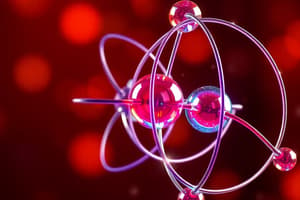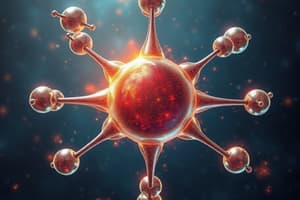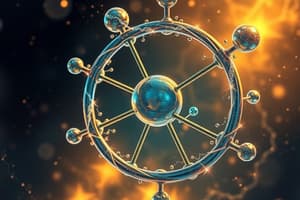Podcast
Questions and Answers
What is the correct formula for the ionic compound formed from sodium (Na) and oxygen (O)?
What is the correct formula for the ionic compound formed from sodium (Na) and oxygen (O)?
- Na2O2
- NaO
- Na2O (correct)
- NaO2
Which of the following statements correctly describes a covalent bond?
Which of the following statements correctly describes a covalent bond?
- Electrons are transferred between atoms.
- A bond is formed through hydrogen loss.
- Attractive forces between positive and negative ions occur.
- Atoms share pairs of electrons. (correct)
Identify the bond type for potassium (K) and bromine (Br).
Identify the bond type for potassium (K) and bromine (Br).
- Ionic bond (correct)
- Coordinate bond
- Covalent bond
- Nonpolar bond
Which compound has a covalent network structure?
Which compound has a covalent network structure?
What would be a simple test to determine if a compound is ionic or covalent?
What would be a simple test to determine if a compound is ionic or covalent?
Which of the following correctly describes ionic compounds?
Which of the following correctly describes ionic compounds?
Of the following bonds, which is considered a polar bond?
Of the following bonds, which is considered a polar bond?
What is the bond angle of a water (H2O) molecule?
What is the bond angle of a water (H2O) molecule?
Flashcards
Why do atoms bond?
Why do atoms bond?
Atoms bond to achieve a stable electron configuration, usually by gaining, losing, or sharing electrons to have a full outer shell (8 valence electrons) like noble gases.
Ionic Bond: Definition & Example
Ionic Bond: Definition & Example
An ionic bond is formed by the electrostatic attraction between oppositely charged ions. It occurs when one atom donates electrons to another, creating a cation (positive ion) and an anion (negative ion). Example: NaCl (Sodium Chloride) where sodium (Na+) loses an electron to chlorine (Cl-) forming an ionic bond.
Covalent Bond: Definition & Example
Covalent Bond: Definition & Example
A covalent bond is formed by the sharing of electrons between two atoms to achieve a stable electron configuration. The shared electrons are attracted to both nuclei. Example: H2O (Water) where two hydrogen atoms share electrons with oxygen.
Lewis Structure: Ionic Bonding (Ca & Br)
Lewis Structure: Ionic Bonding (Ca & Br)
Signup and view all the flashcards
Polar Bond vs. Nonpolar Bond
Polar Bond vs. Nonpolar Bond
Signup and view all the flashcards
Metallic Bond
Metallic Bond
Signup and view all the flashcards
Covalent Network Bonding: Definition & Example
Covalent Network Bonding: Definition & Example
Signup and view all the flashcards
Ionic compound vs. Covalent compound test
Ionic compound vs. Covalent compound test
Signup and view all the flashcards
Study Notes
Bonding Review – Honors Chemistry
-
Why do atoms bond? Atoms bond to achieve a more stable electron configuration, usually by filling their outermost electron shell (octet rule).
-
Octet Rule: Atoms tend to gain, lose, or share electrons to achieve a full outer electron shell of eight valence electrons (except for hydrogen and helium, which are stable with two).
Ionic Bonds
-
Definition: Ionic bonds form when one or more electrons are transferred from a metal atom to a nonmetal atom. This creates oppositely charged ions that are attracted to each other due to electrostatic forces.
-
Example: Sodium chloride (NaCl). Sodium loses one electron to become Na⁺, and chlorine gains one electron to become Cl⁻. These oppositely charged ions attract, forming an ionic bond.
Covalent Bonds
-
Definition: Covalent bonds form when atoms share one or more pairs of electrons. This sharing allows both atoms to achieve a more stable electron configuration resembling a full outer shell.
-
Example: Water (H₂O). Hydrogen and oxygen share electrons to complete their respective outer electron shells.
Ionic Compound Formulas
- Na and O: Na₂O
- Al and Cl: AlCl₃
- Fe²⁺ and N³⁻: Fe₃N₂
Lewis Structure - Ca and Br
- Formula: CaBr₂
- Lewis Structure: A Lewis structure showing Ca transferring two electrons to two Br atoms, forming Ca²⁺ and two Br⁻ ions.
Compound Names
- N₂O: Dinitrogen monoxide
- SnS₂: Tin(IV) sulfide
- Ba(ClO₂)₂: Barium chlorite
- FeSO₄: Iron(II) sulfate
- PCl₅: Phosphorus pentachloride
- Ca₃(PO₄)₂: Calcium phosphate
- BeC₂O₄: Beryllium oxalate
- CF₄: Carbon tetrafluoride
Compound Formulas
- Sulfur hexafluoride: SF₆
- Copper(II) nitrate: Cu(NO₃)₂
- Cesium oxide: Cs₂O
- Ammonium phosphite: (NH₄)₃PO₃
- Lead(IV) chloride: PbCl₄
- Diphosphorous pentoxide: P₂O₅
- Aluminum sulfite: Al₂(SO₃)₃
- Nitrogen monoxide: NO
Ionic Compounds – Structure and Properties
- Structure: Arranged in a crystal lattice structure with alternating positive and negative ions.
- Properties: Typically hard, brittle, high melting/boiling points, dissolve in water to form conducting solutions.
- Examples: Sodium chloride (NaCl), potassium iodide (KI), magnesium oxide (MgO).
Covalent Compounds – Structure and Properties
- Structure: Atoms are bonded to form molecules; molecules are held together by weaker intermolecular forces.
- Properties: Generally lower melting/boiling points than ionic compounds, many are gases or liquids at room temperature, many are not soluble in water.
- Examples: Water (H₂O), methane (CH₄), carbon dioxide (CO₂).
Identifying Ionic vs. Covalent
- Test: Melt the compound and check if it conducts electricity.
- If it conducts when melted, it is ionic.
- If it does not conduct when melted, it's likely covalent.
Lewis Structures (Question 11)
- Lewis Structures are visual representations of how valence electrons are shared or transferred in a bond. For each requested molecule, the Lewis structure diagrams the bonding, as well as the lone pairs of electrons. This structural information was not explicitly supplied and students should use the formulas and rules to draw correct structures.
Bond Types (Question 14)
- Polar: Unequal sharing of electrons between atoms, creating a dipole moment.
- Nonpolar: Equal sharing of electrons, no dipole moment.
- Ionic: complete transfer of electrons, creating charged ions.
Metallic Bonds
- Definition: Metallic bonds involve the sharing of many delocalized electrons in a metal. The electrons are free to move between atoms, resulting in a strong attraction between positive metal ions and the surrounding "sea" of electrons.
Covalent Network Bonds
- Description: Covalent network bonds form an extensive network of strongly bonded atoms. These networks are effectively giant molecules.
- Example: Diamond (carbon)
- Properties: Covalent network substances are typically very hard, have high melting points, and poor electrical conductivity.
Studying That Suits You
Use AI to generate personalized quizzes and flashcards to suit your learning preferences.




